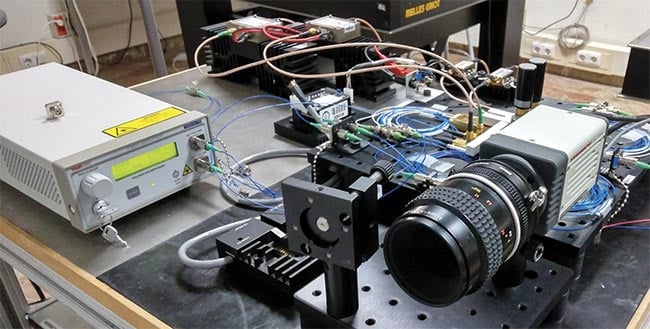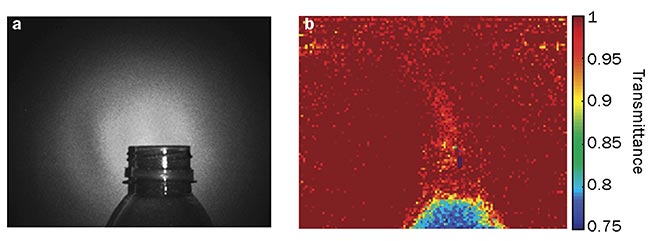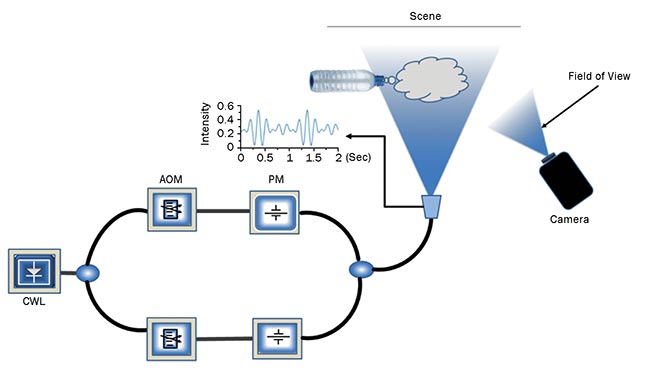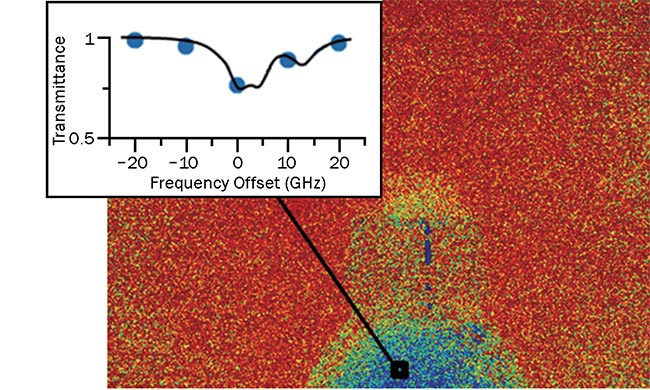Research demonstrates how optical frequency combs could transform conventional video cameras into fast-capture hyperspectral imagers that deliver high optical resolution and acquisition rates.
FARID ULLAH KHAN AND PEDRO MARTÍN-MATEOS, UNIVERSITY CARLOS III DE MADRID
An optical frequency comb is an optical source characterized by a spectrum consisting of evenly spaced frequency lines, known as teeth. This Nobel Prize-winning technology has become a reference tool for optical frequency metrology and spectroscopy and has also found use in a range of other applications, including precision ranging, arbitrary signal generation, advanced telecommunications, and spectrograph calibration.

The camera, behind which is located the all-fiber dual-comb generator (right), in the second iteration of the direct hyperspectral dual-comb imaging system. Courtesy of University Carlos III de Madrid.
By itself, a single stabilized optical
frequency comb provides superb frequency accuracy and resolution. But in most applications, a dual-comb approach is employed to gain access to every
individual tooth, which is otherwise a challenging task. Dual-comb spectroscopy combines, or heterodynes, two
coherent frequency combs with marginally different repetition rates on a photodetector, allowing the teeth to be mapped one by one from the optical to the radio frequency domain where signal acquisition and processing is more straightforward. This approach delivers notable performance advantages compared to traditional spectrometric detection methods by providing single-tooth resolved spectra, high measurement speed, and high sensitivity without the need for moving parts or size constraints1.
Recent technological developments have triggered the evolution of new dual-comb sources that promise to surpass the performance of conventional mode-locked laser-based combs in some respects. Frequency combs based on microresonators or quantum cascade lasers have been extensively studied in the last years and are finding increasing use. Electro-optic combs offer another attractive alternative by providing flexible line spacing and outstanding control over generated signals. Electro-optics also introduce interesting possibilities for applying optical frequency combs to hyperspectral imaging.
Hyperspectral imaging techniques
In recent years, and in parallel with the development of frequency comb-based systems, there has been a rapid upsurge
in demand for hyperspectral imaging
systems, due primarily to a growing
number of applications in biomedical research, environmental monitoring,
and quality control in agriculture and food products.
Generally speaking, hyperspectral imaging extends traditional active or passive spectroscopy to a two-dimensional scenario in which each pixel of the image also provides a spectral characterization. In view of the outstanding capabilities of dual-comb spectrometers, there has always been a strong interest in combining the technology with hyperspectral imaging methods.
This was first achieved with a raster scanning approach that employed a
traditional dual-comb system in which
the sample was moved using translation
stages. Raster scanning, however, introduces waiting times between spectral characterizations that can have an adverse impact on image acquisition speed. But impressive analytical results have been achieved through this method2,3.
More recent attempts to perform dual-comb imaging without scanning the sample have leveraged structured illumination, though acquisition rates remain within the same order of magnitude as raster scanning methods, taking several minutes or more per image, depending on the number of pixels required4.
Direct hyperspectral imaging
These previous approaches aside, the most efficient way to achieve dual-comb hyperspectral imaging with faster measurement times is by enabling a camera sensor to directly read the interferometric dual-comb signal. Although simple in concept, experimental demonstration of this idea has been hindered by technological challenges associated with the limited frame rates at which most cameras operate. Reading dual-comb heterodyning products at a few samples (or frames) per second requires stretching the comb’s interferogram periods from nanoseconds to seconds, which imposes strong constraints on the mutual coherence between combs. In addition, the spectral coverage and the number of teeth of each comb must be accurately controlled to comply with the Nyquist frequency of the camera, which is defined as half the camera’s sampling frequency.

A frame acquired by the camera during the experiment. The plastic bottle was filled with a solution of ammonia (a). The spectral transmittance of a molecular transition of ammonia at 1532 nm after processing (b). The presence of the gas ammonia is evident by the blue color, which indicates a high gas concentration. Courtesy of University Carlos III de Madrid.

A direct hyperspectral dual-comb imaging (DHDCI) system. In the experimental demonstration, the dual-comb generator was employed to illuminate a scene in which ammonia was present. The graph represents the time-dependent optical intensity of a typical DHDCI illumination signal. Two interferograms are shown. CWL: continuous-wave laser; AOM: acousto-optic modulator; PM: phase modulator. Courtesy of University Carlos III de Madrid.
The technology best positioned to meet these requirements is the aforementioned electro-optic dual-comb generation method. This technique is based on strong nonlinear modulation of the signal from a continuous-wave laser using electro-optic modulators to generate lower and higher frequency sidebands that determine the structure of a single frequency comb.
Alternatively, if the signal from the laser
is split into two paths and directed through two modulators driven at slightly different frequencies, then a dual-comb signal is generated. Additional acousto-optic modulators can then be employed
to avoid overlap between higher and lower frequency teeth. This approach will inherently provide superb coherence between the dual combs.
A recent demonstration of a practical direct hyperspectral dual-comb imaging
system applied this electro-optic approach to generate a dual-comb signal in the near-infrared5. The demonstration achieved spectral compression ratios exceeding 1010, enabling the optical spectra of the combs to be squeezed into a radio frequency bandwidth of less than 10 Hz. It further permitted generation of very low-frequency interferograms, enabling direct detection of hyperspectral data by every pixel of a camera sensor operating at regular video rates, and allowing precision spectroscopy of two-dimensional samples.
Additionally, the demonstrated dual-comb source features a freely adjustable intertooth spacing (i.e., optical resolution) and an optical span that is more than sufficient for the study of gas-phase molecular transitions.

Besides gas detection, identification, and estimation of concentration, the experimental arrangement could accurately recover the spectral response of the sample. The measurement (inset) shows a spectral fit as a function of the frequency offset from 1531.68 nm. Courtesy of University Carlos III de Madrid.
In particular, a laser emitting at approximately 1532 nm — the central frequency of the dual-comb — was employed to target ammonia. In contrast with previous attempts, the novel approach described proved capable of performing the spectral characterization of a particular scene simultaneously using the 327,680 pixels of the camera in a single second. With the use of faster cameras, this level of performance is expected to increase strikingly in the years to come. These results introduce a completely new palette of opportunities for performing precision spectroscopy of dynamic samples in two dimensions with unmatched optical and temporal resolution, and expanding most of the point-detection capabilities of current dual-comb systems to hyperspectral imaging arrangements.
New opportunities
Viewed from a different perspective, the electro-optic dual-comb illumination source described is capable of transforming a regular video camera into a fast-capture hyperspectral imager with unmatched optical resolution and a high acquisition rate. Continued exploration of the method’s capabilities could further expand its spectral coverage, optical resolution, and acquisition speed. With the addition of a dispersive dual-comb interferometric arrangement to the setup, in which one frequency comb is used to analyze the sample and the second is treated as the phase reference, phase imaging can be achieved for precise and absolute 3D mapping.
With respect to the wavelength range, the electro-optic dual-comb system was experimentally validated in the near-infrared band for the sake of simplicity. This is the usual operation range of these generators. Nevertheless, the fundamental vibration bands of most common molecules of interest lie in the mid-infrared. Generally speaking, this implies that spectroscopic systems operating in the mid-infrared surpass the sensitivity of near-infrared devices by several orders of magnitude.
This invites further exploration of difference-frequency generation to frequency-shift arbitrary signals from the near-infrared to the mid-infrared. In this way, the direct dual-comb hyperspectral imaging approach offers straightforward access to the mid-infrared window to enable accurate optical imaging of chemical compounds. Precision hyperspectral imaging will bring completely new levels of sensitivity and selectivity to the optical gas imaging scene. The use of fast mid-infrared cameras will also enable the analysis of liquids and solids characterized by far wider spectral features because hundreds of comb teeth could be used to interrogate the samples.
Another frequency range in which the dual-comb imaging technique offers interesting possibilities is the millimeter-wave and terahertz window. The moderate optical span of simple electro-optic comb generators does not impose limitations
in this range, and the number of possible applications in the industry, from the monitoring of plastic fabrication to the quality control of pharmaceutical products, are countless.
Meet the authors
Farid Ullah Khan is a doctoral student in
photonics at the Electronic Technology
Department at the University Carlos III de Madrid in Spain. His current research interests are in photonics, optical frequency combs,
and new spectroscopic sensing techniques; email: [email protected].
Pedro Martín-Mateos is an assistant
professor at University Carlos III de Madrid. His research interests focus on the development of new spectroscopic techniques for analytical chemistry, environmental monitoring, and biomedical research; email: [email protected].
References
1. G.B. Rieker et al. (2014). Frequency-comb-based remote sensing of greenhouse gases over kilometer air paths. Optica, Vol. 1,
p. 290.
2. T. Ideguchi et al. (2013). Coherent Raman spectro-imaging with laser frequency combs. Nature, Vol. 502, p. 355.
3. L.A. Sterczewski et al. (2019). Terahertz hyperspectral imaging with dual chip-scale combs. Optica, Vol. 6, p. 766.
4. K. Shibuya et al. (2017). Scan-less hyperspectral dual-comb single-pixel-imaging
in both amplitude and phase. Opt Express,
Vol. 25, p. 21947.
5. P. Martín-Mateos et al. (2020). Direct hyperspectral dual-comb imaging. Optica, Vol. 7, p. 199.